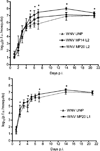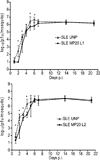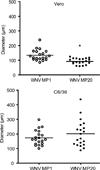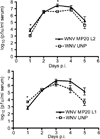Characterization of mosquito-adapted West Nile virus
- PMID: 18559933
- PMCID: PMC3249650
- DOI: 10.1099/vir.0.2008/000893-0
Characterization of mosquito-adapted West Nile virus
Abstract
West Nile virus (WNV), a mosquito-borne flavivirus, has significantly expanded its geographical and host range since its 1999 introduction into North America. The underlying mechanisms of evolution of WNV and other arboviruses are still poorly understood. Studies evaluating virus adaptation and fitness in relevant in vivo systems are largely lacking. In order to evaluate the capacity for host-specific adaptation and the genetic correlates of adaptation in vivo, this study measured phenotypic and genotypic changes in WNV resulting from passage in Culex pipiens mosquitoes. An increase in replicative ability of WNV in C. pipiens was attained for the two lineages of WNV tested. This adaptation for replication in mosquitoes did not result in a replicative cost in chickens, but did decrease cell-to-cell spread of virus in vertebrate cell culture. Genetic analyses of one mosquito-adapted lineage revealed a total of nine consensus nucleotide substitutions with no accumulation of a significant mutant spectrum. These results differed significantly from previous in vitro studies. When St Louis encephalitis virus (SLEV), a closely related flavivirus, was passaged in C. pipiens, moderately attenuated growth in C. pipiens was observed for two lineages tested. These results suggest that significant differences in the capacity for mosquito adaptation may exist between WNV and SLEV, and demonstrate that further comparative studies in relevant in vivo systems will help elucidate the still largely unknown mechanisms of arboviral adaptation in ecologically relevant hosts.
Figures




Similar articles
-
Experimental passage of St. Louis encephalitis virus in vivo in mosquitoes and chickens reveals evolutionarily significant virus characteristics.PLoS One. 2009 Nov 17;4(11):e7876. doi: 10.1371/journal.pone.0007876. PLoS One. 2009. PMID: 19924238 Free PMC article.
-
Point mutations in the West Nile virus (Flaviviridae; Flavivirus) RNA-dependent RNA polymerase alter viral fitness in a host-dependent manner in vitro and in vivo.Virology. 2012 May 25;427(1):18-24. doi: 10.1016/j.virol.2012.01.036. Epub 2012 Feb 23. Virology. 2012. PMID: 22365326 Free PMC article.
-
Noncoding Subgenomic Flavivirus RNA Is Processed by the Mosquito RNA Interference Machinery and Determines West Nile Virus Transmission by Culex pipiens Mosquitoes.J Virol. 2016 Oct 28;90(22):10145-10159. doi: 10.1128/JVI.00930-16. Print 2016 Nov 15. J Virol. 2016. PMID: 27581979 Free PMC article.
-
Mosquito species involved in the circulation of West Nile and Usutu viruses in Italy.Vet Ital. 2017 Jun 30;53(2):97-110. doi: 10.12834/VetIt.114.933.4764.2. Vet Ital. 2017. PMID: 28675249 Review.
-
Dynamics of West Nile virus evolution in mosquito vectors.Curr Opin Virol. 2016 Dec;21:132-138. doi: 10.1016/j.coviro.2016.09.007. Epub 2016 Oct 24. Curr Opin Virol. 2016. PMID: 27788400 Free PMC article. Review.
Cited by
-
Evolutionary dynamics and molecular epidemiology of West Nile virus in New York State: 1999-2015.Virus Evol. 2019 Jul 21;5(2):vez020. doi: 10.1093/ve/vez020. eCollection 2019 Jul. Virus Evol. 2019. PMID: 31341640 Free PMC article.
-
Factors shaping the adaptive landscape for arboviruses: implications for the emergence of disease.Future Microbiol. 2013 Feb;8(2):155-76. doi: 10.2217/fmb.12.139. Future Microbiol. 2013. PMID: 23374123 Free PMC article. Review.
-
Experimental Evolution of West Nile Virus at Higher Temperatures Facilitates Broad Adaptation and Increased Genetic Diversity.Viruses. 2021 Sep 22;13(10):1889. doi: 10.3390/v13101889. Viruses. 2021. PMID: 34696323 Free PMC article.
-
West Nile virus adaptation to ixodid tick cells is associated with phenotypic trade-offs in primary hosts.Virology. 2015 Aug;482:128-32. doi: 10.1016/j.virol.2015.03.033. Epub 2015 Apr 9. Virology. 2015. PMID: 25863877 Free PMC article.
-
Genetic analysis of West Nile virus isolates from an outbreak in Idaho, United States, 2006-2007.Int J Environ Res Public Health. 2013 Sep 23;10(9):4486-506. doi: 10.3390/ijerph10094486. Int J Environ Res Public Health. 2013. PMID: 24065039 Free PMC article.
References
-
- Aitken THG. An in vitro feeding technique for artificially demonstrating virus transmission by mosquitoes. Mosq News. 1977;37:130–133.
-
- Carrillo C, Borca M, Moore DM, Morgan DO, Sobrino F. In vivo analysis of the stability and fitness of variants recovered from foot-and-mouth disease virus quasispecies. J Gen Virol. 1998;79:1699–1706. - PubMed
-
- Chamberlain RW. History of St Louis encephalitis. In: Monath TP, editor. St Louis Encephalitis. Washington, DC: American Public Health Assoc; 1980. pp. 3–61.
-
- Chambers TJ, Hahn CS, Galler R, Rice CM. Flavivirus genome organization, expression, and replication. Annu Rev Microbiol. 1990;44:649–688. - PubMed
Publication types
MeSH terms
Substances
Grants and funding
LinkOut - more resources
Full Text Sources

